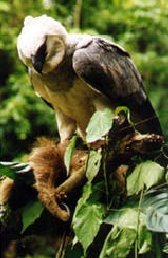|
Notes from the Field Harpy Eagle Releases in Panama |
|
James is Released
May 1999
Female MV forages far and wide within Camino de Cruces National Park while the youngest harpy, male
AC remains near his "nest"--the hack site.
This month we toured Panama, presenting our cause to a variety of audiences including schools, communities and various governmental agencies.
June 1999
On June 15 we released James, our young male Harpy on Barro Colorado Island. We had aborted his
hack because he had developed a special taste for tracking humans. Thanks to our access to the
Smithsonian Tropical Research Institute’s (STRI) facilities we were able to release him in a completely
protected area. STRI Director Dr. Ira Rubinof , BCI researchers and staff accompanied us for the young
Harpy’s release. Our biologist Yu-Cheng Hsu has devoted his efforts to tracking and observing James as he
resumes his development as a wild eagle. James was released in the center of the island and has settled in a
quiet area abounding with monkeys and other wildlife. After a week of unsuccessful attempts, James
managed to catch an adult three-toed sloth. Since then he has caught several more as well as a coati mundi.
Meanwhile, Francisco Barrios, Bernabe Fernandez and Hilario Rodriguez have attempted to trap the elusive and independent female MV in order to relocate her on BCI.
July 1999
Our youngest male, AC, expands his range and catches his first sloth early this month as anticipated.
James (DC) continues to forage successfully on Barro Colorado Island. Within an hour of capturing and devouring a Kinkajo, he caught a two-toed sloth. Yu-Cheng continues collecting foraging data, particularly the early attempts at the more formidable monkeys. We suspect that young Harpies innately recognize sloths as prey but learn to take monkeys only after developing strategies to do so. Female MV keeps roaming a large area of forest in Camino de Cruces National Park. Having hunted on her own for about six months, she is indistinguishable in her habits from the wild birds we study. Venezuelan field biologist Rafael Alvarez is rejoining our staff in Panama this month. Rafael has located many Harpy Eagle nests in Venezuela and Panama and will be working with Angel Muela locating and studying wild populations in Darien and Chagres National Parks.
August 1999
Angel Muela and Rafael Alvarez hosted ecologists Susan Harrison, Robert Howe, Amy Wolf, and Sid
England from the University of California and the University of Wisconsin. They managed to retrap male DC
(James) on Barro Colorado Island in order to refit transmitters as well as confirm Harpy Eagle sightings in
the Western Atlantic side of Panama around Bocas del Toro. They recovered the remains of an adult female
shot there and managed to convince the local who shot the eagle to work with us in finding birds rather than
hunting them. Often, the mere interest in an animal suffices in averting hunting pressure, especially when there
is no economic gain involved.
By Alberto Palleroni
| |||||||||||||||||
